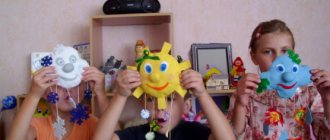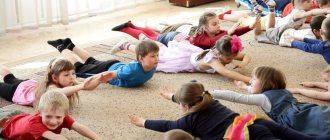What is breathing exercises?
Breathing exercises are a set of exercises aimed at developing and strengthening the body’s respiratory system. Prescribed for therapeutic and prophylactic purposes. Gymnastics is widely used as part of complex therapy in the treatment of diseases, as well as for general health improvement in children of preschool and school age.
Breathing exercises help prevent colds and bronchitis, recover from pneumonia and strengthen the child’s immunity. Developing the respiratory system increases the body's endurance during physical activity and improves brain function.
With regular exercise, lung volume increases and the respiratory muscles are strengthened. People suffering from bronchial asthma experience a reduction in the frequency of attacks.
REFERENCE! Breathing exercises saturate the child’s brain cells with oxygen - this helps him remember information better and participate more actively in the learning process.
The importance of breathing exercises when working with preschoolers
Many preschool children have fragile immunity: they are susceptible to frequent respiratory diseases, suffer from a runny nose, and prolonged cough. And parents sometimes don’t even realize that the cause of this may be improper shallow breathing. In this case, inhalation and exhalation of air does not occur at full strength. As a result, there is no complete ventilation of the lungs, and the growing body lacks oxygen. The brain and other important organs suffer from this, all cells starve, weakening their barriers to harmful microorganisms.
In addition to frequent acute respiratory infections, a baby with a poorly developed respiratory system, as a rule, is pale, drowsy and slow. He gets used to breathing through his mouth and is not very developed physically - he has weak muscles.
The key goal of breathing exercises is to teach a preschooler to breathe correctly, and therefore improve his health. The lungs should fill as much as possible during inhalation, and the chest should expand. When exhaling, it is extremely important that all the air is released, otherwise the remaining air will limit the flow of new air in the required volume.
Along with this, there are also exercises, on the contrary, aimed at training fast breathing. They have their own benefits - they help strengthen the nasopharynx and larynx.
The importance of breathing exercises for preschoolers is very great:
- All cells of the body are saturated with oxygen, metabolic processes improve, and all organs begin to function fully. The child becomes less susceptible to respiratory diseases: the disease goes away faster, and the likelihood of developing complications is reduced.
- Exercises help in the fight against existing chronic diseases: asthma, sinusitis, problems with adenoids, etc.
- Speech breathing defects are corrected, the speech apparatus is strengthened, which helps eliminate speech therapy problems.
- Since the brain receives adequate oxygen supply, children become more efficient and active, and their intellect develops better.
- Physical development also improves. Physical education classes with proper breathing bring more benefits, the child develops muscles and a healthy complexion.
- Exercises teach preschoolers to control their breathing. As a result, the ability to control one’s own actions and to control one’s own actions is formed.
- Inhaling slowly promotes relaxation and calm (this is especially important for hyperactive children), helps fight anxiety, excessive irritability, and emotional fatigue.
Interestingly, breathing exercises have very few contraindications. For example, it is undesirable to perform gymnastics for children who have suffered injuries to the brain, spine, osteochondrosis of the cervicothoracic vertebral region, as well as high blood pressure (arterial, intraocular, intracranial).
If a child has asthma, the intensity of exercise should be discussed with the attending physician.
Recommendations for conducting
In kindergartens, breathing exercises are performed daily once or twice a day. The right time to do it is a morning walk and the period after the end of the “quiet hour”. At school - in physical education classes.
Basic recommendations for all age groups:
- Breathing exercises invigorate the body, so it is not advisable to do them before bed.
- Exercising on an empty stomach can be dangerous and can cause dizziness. At the same time, it is also not worth doing gymnastics immediately after eating in order to avoid digestive problems. The optimal time is an hour after eating.
- Gymnastics must take place in the fresh air. If it is not possible to go outside, the room must be well ventilated.
- There should be no dust in the room where classes are held that children will inhale.
- It is advisable that clothing be loose and not compress the chest and abdomen.
- For children aged two to three years, a complex of one to three lessons , lasting no more than 10 minutes, . Due to their age, they will not be able to practice for longer and may become distracted soon after they begin.
- To attract preschoolers to perform, gymnastics should be carried out in the form of a game. You can also invite children to smell flowers or guess what smell appeared in the air.
- The body should be relaxed during exercise, the muscles of the neck, arms and chest should not be tense.
- When inhaling and exhaling, the cheeks should not puff up (the exception is play exercises for younger children). This can be observed by placing your hands on them.
IMPORTANT! Breathing exercises have contraindications. Exercises are prohibited for persons suffering from heart disease and during acute inflammatory lung diseases and viral infections.
Breathing exercises for preschool children (3–7 years old)
Morozova Galina
Breathing exercises for preschool children (3–7 years old)
Breathing exercises
—
This is a system of breathing exercises aimed mainly at the prevention and treatment of diseases associated with the respiratory system, cardiovascular diseases, and vegetative-vascular dystonia.
Breathing exercises are an integral part of physical education, since every exercise, every human movement is accompanied by inhalation and exhalation.
Respiration is a set of processes that ensure the entry of oxygen into the body and the release of carbon dioxide from it (external respiration) and the use of oxygen by tissues and cells for the oxidation of organic substances with the release of the energy contained in them, necessary for life.
Objectives of breathing exercises:
1. Increasing the child’s overall vitality and the resistance, hardening and resistance of his body to diseases of the respiratory system.
2. Development of respiratory muscles, increased mobility of the chest and diaphragm, improved lymph and blood circulation in the lungs, improved activity of the cardiovascular system and blood circulation.
Breathing exercises are mainly based on the methods of B. S. Tolkachev, A. N. Strelnikova, K. P. Buteyko, Yu. G. Vilunas; healthy breathing according to the yogi system is used.
Breathing exercises according to the method of B. S. Tolkachev are especially recommended for frequently ill children. It is advisable to use exercises with audible exhalation in everyday practice: “r-r-r”, “p-f-f-f”, “tick-tock”, etc.
Rules for performing exercises to develop breathing according to the method of A. N. Strelnikova:
— take an active short breath through the nose;
- exhalation should go out independently through the mouth after each inhalation;
- inhale simultaneously with the movement;
- perform all inhalations and movements at a marching pace;
- count mentally, silently (counting in this gymnastics is by 8, and not by 5 or 10, as in traditional).
How to do gymnastics with preschoolers:
1. Breathing exercises with preschool children can be done twice a day for 10-20 minutes, and it is better to do this no earlier than an hour after eating.
2. It is important that classes are conducted in a playful way that is interesting to children.
3. To make it interesting for children, the exercises can be called childish.
4. Breathing exercises using toys will be interesting.
5. It is useful to do exercises outside in the warm season, in the fresh air.
6. If classes are held indoors, then you need to pre-ventilate it.
7. You need to exercise in light clothing and at an air temperature no higher than 17.
8. It is important to constantly practice breathing exercises with your child, since the results of the exercises will be visible only after a long course.
9. The load can be increased gradually, increasing the number of repetitions and complicating the exercises.
Breathing exercises for junior preschool age.
No. 1 Beetles.
The children sit on chairs, the teacher says: “Zh-zh-zh,” said the winged beetle, “sit-zh-u.”
Children hug themselves by the shoulders and say: “I will rise, I will fly; loud, loud buzz-zh-zh-zh-uh.”
Children spread their arms to the sides and move around the hall pronouncing the sounds “w-w-w-w-w” (2 - 3 minutes).
No. 2 Airplanes
At the teacher’s command, “the engines start” - they say “r-r-r-r” while exhaling; airplanes fly - “w-w-w-w”; turn around on bends - “oo-oo-oo”; landing - “wow-wow-wow.”
Breathing and sound gymnastics “Flight to the Moon.” Junior preschool age.
When performing the exercises, inhale through the nose, mouth closed.
1. “Start the engine.”
I. p. - stand with legs apart, hands in front of the chest, clenched into fists. Inhale - and. P. ; exhale - rotate your bent arms (one around the other) at chest level; At the same time, pronounce “R-r-r-r” with one breath. Repeat 4-6 times.
2. “We’re flying on a rocket.”
I. p. - standing on your knees, arms up, palms clasped above your head. Inhale - and. P. ; long exhalation - sway from side to side, transferring the weight of the body from one leg to the other, pronounce drawn out: “U-oo-oo-oo-oo.” Repeat 4-6 times.
3. “We put on the spacesuit helmet.”
I. p. - squatting, hands clasped above his head. Inhale - and. P. ; exhale - spread your arms to the sides, say: “Chick.” Repeat 4-6 times.
Breathing exercises for middle preschool age.
“Hug your shoulders” Take the starting position: feet shoulder-width apart, arms bent at the elbows and raised to shoulder level. Turn the hands of both hands with your palms facing you and fix them in front of your chest, slightly below your neck. Begin the movement by throwing your arms towards each other, with your left hand “hugging” your right shoulder, and your right hand hugging your left armpit. Make sure your arms are parallel to each other. Inhale through your nose at the moment when your hands come together most closely: the “hug” is over – the inhalation is over. The inhalation is as noisy and short as possible, like a rapierist’s injection. Do not move your arms far from your body and do not straighten your elbows under any circumstances. Observe the simultaneity of bending and “hugs” and do not think about exhaling. Exhale passively - through the mouth.
Breathing exercises for senior preschool age.
Exercise "Hamster". Ask your child to pretend to be a hamster: puff out his cheeks and walk around looking like he is there. Then you need to slap yourself on the cheeks, releasing the air. And then you need to take a few more steps, breathing through your nose, as if sniffing out new food for the next filling of your cheeks.
Exercise "Dragon". Invite your child to imagine himself as a dragon, breathing through each nostril alternately. Let the child close the first nostril with his finger, and let the child inhale and exhale deeply on the other.
Exercise "Throw the ball." Starting position - standing, arms raised up and holding the ball. Invite your child to inhale, and then, as you exhale, throw the ball forward from the chest, while saying a long “uh-uh.”
Breathing exercises for senior preschool age.
Exercise "Hamster". Ask your child to pretend to be a hamster: puff out his cheeks and walk around looking like he is there. Then you need to slap yourself on the cheeks, releasing the air. And then you need to take a few more steps, breathing through your nose, as if sniffing out new food for the next filling of your cheeks.
Exercise "Dragon". Invite your child to imagine himself as a dragon, breathing through each nostril alternately. Let the child close the first nostril with his finger, and let the child inhale and exhale deeply on the other.
Exercise "Throw the ball." Starting position - standing, arms raised up and holding the ball. Invite your child to inhale, and then, as you exhale, throw the ball forward from the chest, while saying a long “uh-uh.”
“Blow out the candle.” Stand straight, feet shoulder-width apart. Take a free breath and hold your breath slightly. Curl your lips. Perform three short, rare exhalations, as if blowing out a burning candle: “Ugh!” Ugh! Ugh!". Keep your torso straight during the exercise.
"Full breath." Stand straight, feet shoulder-width apart. Take a free deep breath while raising your arms up in front of you. Hold your breath (as long as it feels good). Exhale vigorously with your mouth open, while lowering your arms and leaning forward (“Ha!”). Breathe out with relief, as if freeing yourself from worries. Slowly straighten up.
"Hedgehog". Turn your head left and right at the pace of movement. Simultaneously with each nasopharynx (the nostrils move and seem to connect, the neck is tense); exhale softly, voluntarily, through half-open lips.
"Ears". Shaking your head left and right, take deep breaths. The shoulders remain motionless, and the ears stretch towards the shoulders. Make sure that your body does not turn when you tilt your head.
Inhalations are performed with tension in the muscles of the nasopharynx. Exhalation is voluntary.
Breathing exercises according to the method of B. S. Tolkachev.
1. "Rocking chair". I. p. - sitting on a chair, hands on knees. Rock your torso back and forth, saying as you exhale, “F-r-oo-hh!” Repeat 6-8 times.
2. “The Christmas tree is growing.” I. p. – stand up straight, legs slightly apart, lower your arms. Squat down and straighten up, raising your arms upward, wider than your shoulders. When crouching, say: “Fear-x!” Repeat 2-3 times.
3. "Bunny". I. p. - stand up straight, legs slightly apart, lower your arms. When squatting, bend your arms to your shoulders with your palms facing forward, like a bunny standing on its hind legs. Say as you exhale: “Fr!” Repeat slowly 5-7 times.
Exercises for children of different ages
The set of exercises for children of different ages is different. It will be easier for preschoolers to complete activities in a playful way; they need to be involved in the process and interested. Older children can approach gymnastics more consciously - exercises can be done in a calm environment, listening to their body.
Preschool
- “Balloon” Stand with your legs apart and imagine an invisible balloon in your hands. When an adult counts “one, two,” take a deep breath, drawing air into your lungs. On the count of “three, four,” exhale forcefully, filling an imaginary ball. At the same time, show with your hands how the ball increases in size.
- “Hippopotamus” Children sit or lie down, put their hand on their stomach and breathe deeply. An adult says the words: “The hippos sat down and touched their bellies. The tummies swell (inhalation occurs), and then the tummies deflate (exhale).”
- “Birds” Children walk slowly, imitating the movement of a bird’s wings with their hands. When you swing up, you inhale, when you lower your arms, you exhale. At the same time, the adult accompanies the game with the phrases: “The birds are flying south,” “The birds are flapping their wings, lowering their wings.”
- “Soap bubble” Children stand in a circle, holding hands. They must inflate a huge soap bubble, the boundaries of which they themselves have become. Inhale deeply through the nose and exhale forcefully. The imaginary bubble between the children is inflated, and with each exhalation they take a step back. The adult encourages: “Blow up a bubble, blow up big! Don’t burst!” When the children have moved as far as possible from each other, the leader claps his hands and shouts: “The bubble has burst!” Children scatter in different directions (small bubbles fly away).
- “Diving under water” The child must imagine that he has to swim under water. To do this, he takes a deep breath, then holds his breath for the maximum amount of time. In this case, you can hold your nose with your hand or imitate swimming by slowly spreading your arms
REFERENCE! It is very useful to blow soap bubbles and balloons, blow on dandelions and feathers. This promotes the development of fine output regulation.
School
- “Breathing with one nostril” A very useful exercise for improving brain function. Stand up straight, body relaxed. Close your left nostril with your finger and take a deep, long breath. Open your nostril and close your right one, exhale slowly. Then do it in reverse order and repeat 5-6 times.
- “Deep cleansing” Carry out in any comfortable position - sitting, lying or standing. First, exhale as much air as possible from your lungs, then inhale slowly and deeply, protruding your chest forward and trying to squeeze your shoulder blades together. Take three sharp, strong exhalations through closed lips. Repeat the exercise 3 times.
- “Breathing restoration” Basic exercise after physical activity. The child inhales air through the nose, filling the lungs as much as possible. Holds your breath for a few seconds and exhales slowly through your mouth. The exercise is repeated until calm breathing is completely restored.
- “Strengthening the lungs” Stand up straight, arms extended in front of you, clench your fists. Slowly inhale deeply and hold your breath. Make three quick movements, spreading your arms as far as possible to the sides and behind your back and returning them back to the starting position. After this, exhale forcefully.
- “Class for athletes” Take an emphasis position lying on a gymnastic bench. Inhale slowly through your nose and hold your breath. Slowly move your body into a high plank position, resting only on your palms and toes. Return to the starting position and slowly exhale all the air from your lungs.
REFERENCE! Classes with schoolchildren, starting from the first grade, are held for 10-30 minutes.
Types of breathing exercises practiced in kindergarten
In a preschool educational institution (DOU), the following main types of breathing exercises can be distinguished.
Breathing games
The teacher not only invites preschoolers to perform certain useful exercises, but presents them in the form of an exciting game. There are many options here. For example, kids create their own orchestra - some “musicians” are given pipes, others are given harmonicas. As a result, the guys have an interesting time while strengthening their breathing.
Active children will certainly enjoy “Air Football”, in which, in order to score a goal, you don’t need to hit the ball, but blow on it, driving it into the goal. Little creative types will find it interesting to breathe heavily on the glass or mirror so that it fogs up. Then you can draw any picture on the surface.
Children always enjoy playing in the snow - they put snowflakes made from small balls of cotton wool on their palms and blow them off. In the same way, you can arrange leaf fall or the flight of paper butterflies.
A good idea is to have fun competitions, such as “Whose locomotive makes the loudest noise?” Each child receives an empty bottle and blows into it with all his might so that a whistle is heard. Children are guaranteed a lot of positive emotions.
The teacher can intrigue the children by offering them magic boxes (these can be plastic containers from Kinder surprises). Each one is filled with something special: orange peels, dry mint leaves, vanillin, etc. The task of preschoolers is to determine what kind of aroma it is: to do this, they need to inhale the air deeply through their nose.
A variety of ideas for games can be implemented while walking. For example, organize a bubble festival. All children love this activity, and at the same time it strengthens the respiratory system.
Breathing exercises class in kindergarten
When conducting breathing exercises in preschool educational institutions, the age characteristics of preschoolers and the level of difficulty of the exercises should be taken into account. Completing a set of 5–7 tasks takes 8–12 minutes. Stages of gymnastics:
- Introductory part: exercises that do not require complex combinations of movements, inhale and exhale at a normal pace - 2-3 minutes.
- Main part: tasks with a combination of inhalation-exhalation tempo and complicated movements, as well as changing body posture - 4-5 minutes.
- Final part: exercises to restore the rhythm of breathing, static body position - 2-3 minutes.
The ability to breathe correctly is extremely important for a child. After all, this is not only a necessary basis for good health, but also a condition for full mental development. The teacher’s task is to put breathing exercises into an entertaining game form. Funny poems and interesting manuals will come to the rescue. Doing simple exercises will gradually become a habit for preschoolers and will make spending time in kindergarten even more fun.
SOURCE: https://melkie.net/zanyatiya-s-detmi/dyihatelnaya-gimnastika-v-detskom-sadu.html





